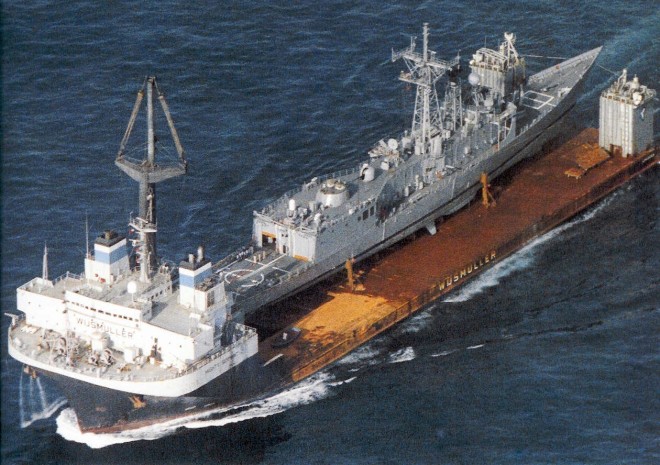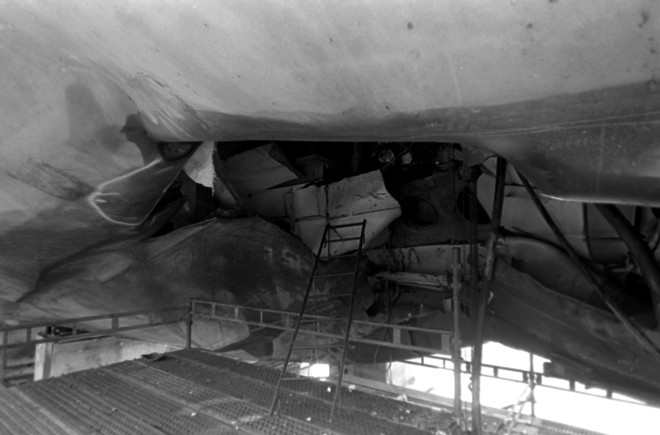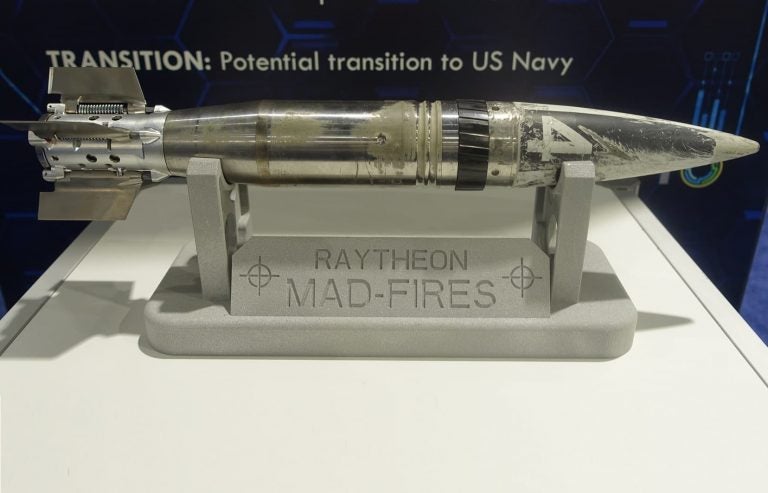The Italian Carlo Bergamini class warships were developed as a part of Franco-Italian FREMM multi-mission frigate program. The same program led to the development of the French
Aquitaine class. Even though resulting Italian Carlo Bergamini class and French
Aquitaine class ships look different, they use many common subsystems. The Carlo Bergamini class bears strong resemblance with the
Horizon class, which was another joint Franco-Italian program.
These Italian Carlo Bergamini class warships are clearly destroyers, but being called frigates for political reasons. There are two variants of the Carlo Bergamini class. One of them are general purpose frigate, that are equally good at all aspects of naval warfare, while the other ships are optimized for anti-submarine warfare role. These have enhanced submarine hunting features, but at a cost of reduced land attack and anti-ship capabilities.
These Italian Carlo Bergamini class warships are clearly destroyers, but being called frigates for political reasons. There are two variants of the Carlo Bergamini class. One of them are general purpose frigate, that are equally good at all aspects of naval warfare, while the other ships are optimized for anti-submarine warfare role. These have enhanced submarine hunting features, but at a cost of reduced land attack and anti-ship capabilities. These Italian warships have enhanced stealth features, including reduced radar cross section and noise levels.
The primary radar is the Selex MFRA multi-functional active phased array radar. It can detect air targets at a range of more than 400 km. It also provides fire control for air defense missiles.
There is a 16-cell VLS for Aster-15 and Aster-30 surface-to-air missiles. The Aster-15 has a range of around 30 km, while the Aster-30 have a range of around 120 km. However this loadout of 16 missiles is comparatively small for such a large warship.
"General purpose" variants of the Carlo Bergamini class are fitted with a single Otobreda 127 mm gun and a single OTO Melara 76 mm gun. "Anti-submarine" variants have two OTO Melara 76 mm guns. The 76 mm guns are dual-purpose weapons. These rapid-firing guns use guided shells and can engage surface, air and land targets. These also act as close-in weapon systems for last ditch defense against incoming missiles. Also there are two 25 mm remotely-controlled cannons that are used to engage small surface threats.
The "general purpose" variant is armed with four
OTOMAT anti-ship missiles. These have a range of around 200 km. The ASW variant is armed with four MILAS anti-submarine missiles, that drop torpedo remotely from the ship.
Also there are two tripple launchers for EUROTORP MU90 lightweight torpedoes. These are present on both "general purpose" and "anti-submarine" variants.
These Italian warships have a double hangar for helicopters and can accommodate either two
NH90, or one NH90 and one
AW101. These are used for search and rescue, utility operations, long-range anti-submarine and anti-ship warfare.
The Carlo Bergamini class have an advanced Combined Diesel-Electric and Gas (CODLAG) propulsion system. For normal operation the ships use a single General Electric LM2500+G4 gas turbine, developing 42 900 shp. For slow-speed and quiet anti-submarine operations the ships use hybrid electric propulsion with two 2.5 MW electric motors which are connected to the propeller shafts. These are powered by 4 diesel generators. Maximum speed is 29 knots (55 km/h). Maximum range is 6 700 nautical miles (12 300 km) at 15 knots (28 km/h). So Italian vessels are slightly faster and have longer range than their French counterparts.
Overall the Italian Carlo Bergamini class warships are larger and are superior in many respects to the French Aquitaine class. However the Italian vessels do not carry any land attack cruise missiles, that are present on the French frigates.
The Fridtjof Nansen is a Norwegian class of multi-role frigates, based on the Spanish
Alvaro de Bazan class. A total of five ships were built in Spain for the Norwegian Navy. The first one was commissioned in 2006. All of these frigates are named after the famous Norwegian explorers.
These general purpose frigates have both anti-submarine, anti-ship, land attack and air defense capabilities. A number of design features were incorporated in order to reduce the radar cross section of these frigates, and thus increase their survivability. However the Fridtjof Nansen class ships are not true stealth vessels.
These Norwegian frigates have very advanced weapons and sensors. The ships' weapons feature the Lockheed Martin Naval Electronics AN/SPY-1F AEGIS radar. It is a smaller and less capable version of the AN/SPY-1D AEGIS radar, used on the Spanish
Alvaro de Bazan class frigates, American
Arleigh Burke class destroyers, and some other warships. The multi-function phased array radar can detect air targets at a range of around 160 km and track hundreds of targets simultaneously. The system controls the detection and engagement of hostile air, surface and submarine threats.
There is an 8-cell VLS for RIM-162 Evolved Sea Sparrow Missiles (ESSM). These air defense missiles have a range of 50 km. The VLS holds 32 missiles. The second similar VLS can be fitted for a total capacity of 64 missiles. However these Norwegian warships do not carry any long-ranged surface-to-air missiles.
Anti-ship and land attack capability is provided by eight Kongsberg Naval Strike Missles (NSMs). These cruise missiles have a range of over 185 km and carry a 125 kg warhead.
There is a single OTO Melara 76 mm Super Rapid dual-purpose naval gun. It can engage both surface and air targets. Fridtjof Nansen class can be equipped with a more powerful Otobreda 127 mm gun, in place of the 76 mm gun.
These Norwegian ships have got a hull-mounted sonar, as well as towed sonar for detection of hostile submarines. There are two dual 324 mm torpedo tubes for Sting Ray torpedoes, that provide anti-submarine capability.
The Fridtjof Nansen class frigate can accommodate a single
NH 90 helicopter, which is used for remote anti-submarine and anti-ship roles. Norwegian Navy ordered 6 of these helicopters to operate on their frigates.
These Norwegian warships have a Combined Diesel and Gas (CODAG) propulsion. It uses two Bazan Bravo 12V diesel engines developing 6 000 shp each. These are used for economical cruising. There is also a single General Electric LM2500 gas turbine, developing 25 700 shp. It is used for high speed cruise. The power is delivered to two shafts. Maximum speed of the Fridtjof Nansen class is at least 26 knots (48 km/h). Range is 8 300 km (4 500 nautical miles) at 16 knots (30 km/h).
The Shivalik class warships are one of the newest surface combatants of the Indian Navy. The class consists of three ships. The first one was commissioned in 2010. These are the first Indian-built warships with enhances stealth features. Many extraneous shapes and protrusions were eliminated from the design in order to minimize the radar cross section. Though these frigates are still not yet true stealth vessels.
Due to their size and displacement the Shivalik class ships could be even considered as destroyers. However their armament is too light for a true destroyer. Still though these warships are very capable and are currently among the
most deadly frigates of the world.
These frigates have a strong anti ship and land attack capability. These are armed with a universal 8-cell VLS for
BRAHMOS supersonic cruise missiles and Klub-N anti-ship cruise missile. The BRAHMOS missiles can engage sea or land targets at a range of 290 km, while the Klub-N anti-ship missiles have a range of 440-660 km.
There is a single-arm reloadable launcher for Shtil-1 (SS-N-12) air defense missiles. These missiles have a 40 km range. A magazine holds 24 of these air defense missiles and it takes 6 seconds for the missile to reload. This particular system is badly outdated. All modern warships are fitted with vertical launch systems for their primary surface-to-air missiles. Also the Shtil-1 launcher has a limited firing arc and can engage targets only to the front of the ship. The Shivalik class frigates are also fitted with two 8-cell VLS launchers for Barak-1 air defense missiles. It is a much more modern weapon, used for short-range defense against sea-skimming anti-ship missiles, as well as other threats. A total of 32 of these missiles are carried.
Radars of the Shivalik class can detect air targets at a range of over 350 km. However the fire control radar is of older generation. So these frigates can engage simultaneously only 6 air targets. So these Indian warships are stronger in land attack and anti-ship role, rather than air defense.
There are two 533 mm tubes for heavyweight torpedoes for engaging submarines and surface warships.
These frigates can carry two helicopters. These may be either indigenous
Dhruv light utility helicopter, British
Westland Sea King anti-submarine or multi-purpose helicopter, or Russian
Ka-31 airborne early warning helicopter.
The Chinese Type 054A class frigate (NATO reporting name Jiangkai II) is an improvement on the existing Type 054 class. Until 2016, 21 of these modern vessels have been commissioned. Three more and under construction and two more planned.
Vessels of this class were built primarily for with air-defense, although they can perform anti-surface and anti-submarine warfare missions. Their radar can track up to 40 targets simultaneously at a maximum range of approximately 120 km.
These vessels represent a significant improvement over the original Type 054 for several reasons. The Type 054A has a lighter main gun, improved CIWS, better sensors, and more Surface-to-Air Missiles (SAMs). In addition, the
HQ-16 SAMs fitted on Type 054As have an improved range of 50 km and can attack targets from all angles.
Located amidships are two quadruple anti-ship/land-attack missile launchers that can attack targets up to 250 km distant. Towards the front is a dual-purpose 76 mm gun turret, which can fire effectively at 120 rounds per minute at targets 10 km distant.
ASW armament is composed of two torpedo tubes, sonar, ASW rockets with a range of 1 200 m, and a helicopter.
With survival in mind, the Type 054A is a somewhat “stealthy” design built of radar absorbent material with clean lines free of clutter resulting in the least possible radar return.
Overall, these ships are highly capable escorts, with advanced radar and processing electronics, representing China’s increasing ability to project power in highly dangerous areas. Some sources report, that an improved Type 054B class is being developed in China.
It is the latest class of frigates, ordered by the Russian Navy. It is referred as Krivak IV class in the West. It is based on the
Talwar class frigates, that were built in Russia for the Indian Navy. So far six ships have been ordered. The first of the class, the Admiral Grigorovich, was commissioned in 2016.
These are general-purpose frigates. Their functions are air defense, escorting of other warships and anti-submarine warfare. Some measures were taken to reduce a radar cross section of these new Russian warships. Though these frigates are not true stealthy vessels in any way. Also the Admiral Grigorovich class warships are not as powerful as many contemporary general-purpose frigates.
Most distinguishable weapon of these Russian frigates is an 8-cell VLS for Kalibr (SS-N-27 Sizzler) supersonic cruise missiles. These missiles can engage ships and land targets. The same VLS can also fire Oniks (SS-N-26 Strobile) anti-ship cruise missiles, that have a range of up to 600 km.
Air defense is provided by three 12-cell VLS for Shtil-1 (SS-N-12) air defense missiles. So a total of 36 missiles are ready to use. These missiles have a range of 40 km. Last ditch defense is provided by two Kashtan CIWS. Each of these gun/missile systems uses tow 30 mm rotary cannons and eight 9M311 short-range air defense missiles. The same missiles are used on
Tunguska. There is also a 100 mm A-190 dual-purpose gun, which can engage air targets, surface ships, and bombard land targets. This gun has a maximum range of over 20 km and fires at a rate of up to 80 rounds per minute.
There are two twin 533 mm torpedo tubes for heavyweight torpedoes. These can be used to engage enemy warships and submarines. Also there is a single 12-barrel RBU-6000 anti-submarine rocket launcher in front of the bridge. Reload rockets are stored below the deck.
These warships can accommodate a single helicopter. It can be a
Ka-27 anti-submarine warfare helicopter, or
Ka-31 airborne early warning helicopter.
The Admiral Grigorovich class warships have a Combined Gas or Gas (COGAG) propulsion system. However construction of these ships was postponed due to problems with the engine supply. The first ships have Ukrainian gas turbines. However following the 2014 Russian military aggression, the Ukrainians refused to supply Russia with military technology. As of 2014 some Admiral Grigorovich ships had no engines. These are to be fitted with alternative Russian engines, however these can not be completed before 2019-2020. Some sources report that funding, intended to complete construction of these frigates, was allocated to other Russian MoD projects. So at the moment future of the follow-on warships is uncertain.


 www.thedrive.com
www.thedrive.com


























